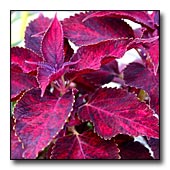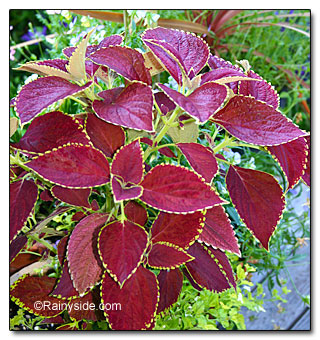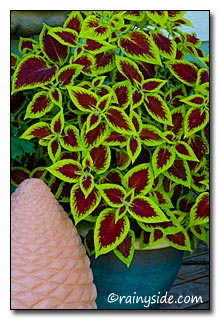Solenostemon scutellarioides
COLEUS, FLAME NETTLE, PAINTED NETTLE
syn. Coleus x hybrida, Coleus blumei
Family: Lamiaceae
Pronounced: sol-en-oh-STEM-on skoot-el-lar-ee-OY-deez

Quick Jumps
Growing Guide
Rainy Side Notes
GROWING GUIDE

Origin:
Southeast Asia and Malaysia.
Plant Group:
Tender perennial.
Mature size:
Height: and width varies with each species and cultivars.
Flowering period:
Any time of the year.
Flowering attributes:
Racemes of small blue and white flowers.
Leaf attributes:
Each cultivar has unique multi-colored foliage.
Light:
Full sun to partial shade, depending on the cultivars.
Soil:
Moist, well-drained, humus rich, fertile soil.
Feeding:
Add a complete organic fertilizer when planting out young plants. Use a high-in-nitrogen fertilizer, such as blood meal, every few weeks, when planted in soil; and use a high-in-nitrogen liquid fertilizer for containers.
Propagation Methods:
To get an early start, sow seed indoors mid March to early April. Do not cover seeds. Germinate at temperatures of 72° F (22° C). Germination will normally occur within 10-14 days. Harden seedlings off and plant outdoors after last frost.
For hybrids, root softwood cuttings from spring to fall.
Pruning Methods:
Pinch young shoots to encourage bushiness. Pinch out flowers to keep plant compact and maintain good foliage color.
Pests and Diseases:
Scale insects, white flies, and mealy bugs may be a problem. Protect young plants from slugs.
Rainy Side Notes

Solenostemon is enjoying resurgence in popularity. Introduced in 1851, it did not take long until early catalogs offered over 150 cultivars. It once was the plant of choice in Victorian gardens, used commonly as an edging plant, in containers or planted out as a bedding plant with Dusty miller. It fell out of favor in the 1960s up until recently. The botanical name was coleus at one time; however, taxonomists changed the name to Solenostemon. Now coleus is exiled to usage as a common name.
I must admit I always fancied this colorful plant. I came to possess it first as a houseplant, and then when I moved to Hawaii, I grew Solenostemon in the garden. I lived in a cottage on the beach and during winter, the salt spray from large storm waves would kill the plants. Annually, I took cuttings before the return of the winter waves and grew the plants indoors. When the salt spray let up, I planted the clones out in the garden.
Solenostemon scutellarioides cultivars are grown for their foliage. Some of them bring spicy-hot looking colors into the garden. Containers use such foliage colors as red, magenta, gold and orange, bringing lively color in without having to rely on flowers. Since coleus has such a variety of colors and foliage, the plant is often selected for designs that need leaf colors to match flowers or make plantings “pop”. In addition, there are subdued tones in the foliage of some coleus that are used to quiet down or compliment other plants. I sometimes use dark purple foliage such as S. 'Black Magic' as a backdrop for other plants. Its striking green edges stand out even more with green plants in the foreground.
Solenostemon scutellarioides can be trained into standards, although a coleus popsicle is not for me. However, for a formal garden, standards would be a lovely addition. Coleus is handsome in hanging baskets or as a foliage plant in a mixed container. I grew one cultivar as a colorful low hedge in Hawaii. Their uses are limited only by your imagination.
The genus likes partial shade. Many new cultivars, however, take full sun, although they will need more moisture to thrive. Here in our cool, maritime climate we can probably provide more sun for the shade tolerant ones. It is important to keep the soil consistently moist, as drying it out will cause the plants to decline. To encourage more foliage, a fertilizer high in nitrogen is best suited for the task. Blood meal in the garden is my high nitrogen fertilizer of choice. Coleus loves to be pinched, and when you pinch out young shoots or flower buds, the plant looks better. The plants grow rapidly. A small plant in spring will reach its optimum height by midsummer.
Here in the Pacific Northwest, we grow coleus as an annual or winter it over indoors and treat it as a short-lived perennial. This is a good plant to learn how to take softwood cuttings to grow new plants. In fact, it was my first plant that I learned how to do this. Cuttings root readily, so instead of wintering over a plant already established in the garden, take cuttings. You can root them in water and pot them up when roots appear, or root the cuttings in a soil-less growing medium and later transplant to a pot. You do not need a greenhouse; just position them in a bright window and wait until spring warms up to take them outside. I grow my cuttings on a heat mat in the greenhouse until the following spring, when the temperature of the soil warms and nighttime temperatures remain above 50°F (10°C). When the weather is warm enough, normally in June, I plant the coleus outdoors.
Although gardeners do not grow Solenostemon for its flowers, the name is comprised of descriptive Greek words for them. Solen is the word for tube and stemon for stamen, because the stamens are joined at the base of the corolla tube. Coleus blooms resemble Scutellaria flowers and thus the epithet—scutellarioides.
Click on thumbnails to view each cultivar of Solennostemon scutellarioides with attributes listed for each one.
Debbie Teashon
Photographed in author's garden.

Gardening for the Homebrewer: Grow and Process Plants for Making Beer, Wine, Gruit, Cider, Perry, and More
By co-authors Debbie Teashon (Rainy Side Gardeners) and Wendy Tweton
Copyright Notice | Home | Search | Annuals



















